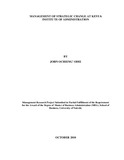| dc.description.abstract | Management of strategic change has become a necessity in modern organizations. This is
because organizational health is mirrored in its ability to strategically adapt to global
influences on modern business. Globalization and internationalization of modern business
requires organizations to develop a global philosophy and approach to business, globally
acceptable approaches and technology, techniques and methods, quality standards,
processes and products for global customers, global marketing approaches, strategic
management practices, global vision of business, globally acceptable political systems to
support and facilitate globalization of business and continuous benchmarking with the
leading players in the industry.
Strategic management has become a global practice for managing strategic change. This
is because it enables organizations to be responsive to environmental needs and changes,
see competitive challenges in advance, achieve operational effectiveness, develop
strategic objectives and actions, effectively mobilize and utilize existing scarce resources
and develop effective directional policy. It has become necessary for organizations to
continuously adapt their subsystems to enable them meet the requirements of the
dynamics in the environment to guarantee their positioning, competitiveness and survival.
This is because an organization, as a functional living organism, has to account for its
existence by having a mission. Strategic management of change provides this answer.
The study sought to establish strategic change management practices at the Institute
which, since its inception in 1961, has continued to operate in a constantly changing
environment. This has been achieved by identifying the strategic change practices and
internal and external factors that influenced them. The accomplishment of the initial
Africanization process, competition for scarce resources, expansion of size and services,
bad governance, increased democratization, International Monetary Fund’s and World
Bank’s intervention and the government’s reactive and proactive policy decisions
fundamentally influenced the Institutes’ strategic change management practices.
This case study employed interview, desk review, observation and content analysis
methods to collect and process primary and secondary data. The study found that the
Institute has over the years, strategically changed its purpose, physical infrastructure,
technology, status, organizational structure, leadership, business, training content, scope
and approaches. Strategic change is expected to continue in response to changes brought
about by the promulgation of the New Constitution and the enactment of laws that will
give it effect. | en |

